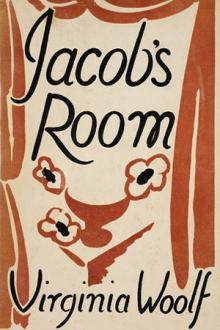author - "Virginia Woolf"

ction?--notfor publication, of course.""I should suppose not," said Ridley significantly. "For a Divine hewas--remarkably free." "The Pump in Neville's Row, for example?" enquired Mr. Pepper. "Precisely," said Ambrose. Each of the ladies, being after the fashion of their sex, highly trainedin promoting men's talk without listening to it, could think--about theeducation of children, about the use of fog sirens in an opera--withoutbetraying herself.

fall and possible demise-- for where was he? what was he? Shading her eyes, she looked along the road for Captain Barfoot--yes, there he was, punctual as ever; the attentions of the Captain--all ripened Betty Flanders, enlarged her figure, tinged her face with jollity, and flooded her eyes for no reason that any one could see perhaps three times a day.True, there's no harm in crying for one's husband, and the tombstone, though plain, was a solid piece of work, and on summer's days when the

it, as he laid down the manuscript and said:"You must be very proud of your family, Miss Hilbery." "Yes, I am," Katharine answered, and she added, "Do you think there's anything wrong in that?" "Wrong? How should it be wrong? It must be a bore, though, showing your things to visitors," he added reflectively. "Not if the visitors like them." "Isn't it difficult to live up to your ancestors?" he proceeded. "I dare say I shouldn't

Description Miss Rachel Vinrace, aged twenty-four and previously interested only in music, is on a voyage both literal and metaphorical. An ocean cruise with her father leaves her for the summer at her Aunt’s villa in an unnamed South American country, where she meets the English inhabitants of the local town’s hotel. As the season progresses she starts to become entangled in their own lives and passions, and through those burgeoning acquaintances and friendships the discovery of her own nature

Description Probably Virginia Woolf’s best-known novel, Mrs. Dalloway, originally published in 1925, is a glorious, ground-breaking text. On the surface, it follows Clarissa Dalloway, an Englishwoman in her fifties, minute by minute through the June day on which she is having a party. At a deeper level, however, the novel demonstrates, through an effortless stream of consciousness, the connections formed in human interaction—whether these interactions are fleeting, or persist through decades.

Description In her third novel, Virginia Woolf departs from conventional narrative and explores storytelling through discordant scenes and impressions. Jacob Flander’s life story is told through the perspectives of the people in his life. In Jacob’s Room, we see Jacob grow from a young boy to an ardent student of Classical culture while the world around him moves closer to an impending war. Jacob is described in flashes by the women around him—his mother and his lovers.

ction?--notfor publication, of course.""I should suppose not," said Ridley significantly. "For a Divine hewas--remarkably free." "The Pump in Neville's Row, for example?" enquired Mr. Pepper. "Precisely," said Ambrose. Each of the ladies, being after the fashion of their sex, highly trainedin promoting men's talk without listening to it, could think--about theeducation of children, about the use of fog sirens in an opera--withoutbetraying herself.

fall and possible demise-- for where was he? what was he? Shading her eyes, she looked along the road for Captain Barfoot--yes, there he was, punctual as ever; the attentions of the Captain--all ripened Betty Flanders, enlarged her figure, tinged her face with jollity, and flooded her eyes for no reason that any one could see perhaps three times a day.True, there's no harm in crying for one's husband, and the tombstone, though plain, was a solid piece of work, and on summer's days when the

it, as he laid down the manuscript and said:"You must be very proud of your family, Miss Hilbery." "Yes, I am," Katharine answered, and she added, "Do you think there's anything wrong in that?" "Wrong? How should it be wrong? It must be a bore, though, showing your things to visitors," he added reflectively. "Not if the visitors like them." "Isn't it difficult to live up to your ancestors?" he proceeded. "I dare say I shouldn't

Description Miss Rachel Vinrace, aged twenty-four and previously interested only in music, is on a voyage both literal and metaphorical. An ocean cruise with her father leaves her for the summer at her Aunt’s villa in an unnamed South American country, where she meets the English inhabitants of the local town’s hotel. As the season progresses she starts to become entangled in their own lives and passions, and through those burgeoning acquaintances and friendships the discovery of her own nature

Description Probably Virginia Woolf’s best-known novel, Mrs. Dalloway, originally published in 1925, is a glorious, ground-breaking text. On the surface, it follows Clarissa Dalloway, an Englishwoman in her fifties, minute by minute through the June day on which she is having a party. At a deeper level, however, the novel demonstrates, through an effortless stream of consciousness, the connections formed in human interaction—whether these interactions are fleeting, or persist through decades.

Description In her third novel, Virginia Woolf departs from conventional narrative and explores storytelling through discordant scenes and impressions. Jacob Flander’s life story is told through the perspectives of the people in his life. In Jacob’s Room, we see Jacob grow from a young boy to an ardent student of Classical culture while the world around him moves closer to an impending war. Jacob is described in flashes by the women around him—his mother and his lovers.